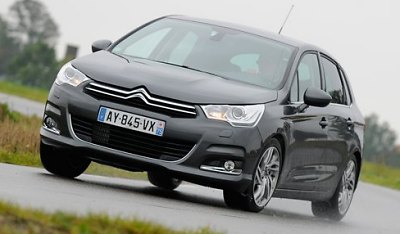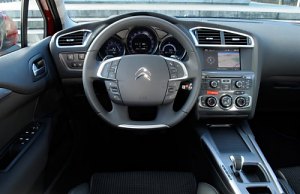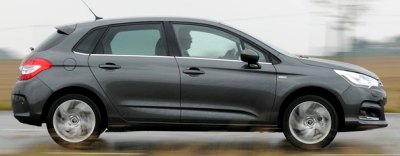Citroen C4
Debut: 2010 |
||||||
This bring us to a question: why did Citroen change the successful formula ? Some said the new C4 is deliberately made conservative in order to leave room to the forthcoming DS4 Highrider. That's a good point, but more telling is that the whole Citroen range is also shifting its design philosophy. New cars like C3, C3 Picasso and DS3 had abandoned the old design theme and opted for a more conventional / practical shape compensated with heavy decoration. They show that Citroen is putting more emphasis on functions than form. That might be a good idea to steal sales from Volkswagen, but not necessarily good to a mould-breaking French marque.
The interior sees a similar shift from style to function.
The old car's centrally-mounted instrument has been replaced with a
conventional layout, which actually improves ergonomics. Not so great
is the conventional steering wheel. We definitely prefer the old
car's fixed hub wheel, which not only looked special but also enabled a
lot of switches located on the hub for convenient access. In the
new car, some of the switches have to be moved to the center console,
whereas the remaining swivel together with the wheel, so they are not
as intuitive to locate. The conventional steering wheel might be a few
dozen dollars cheaper to source, but does that justify the loss of
uniqueness ?
Nevertheless, this cabin is a nicer place to spend time. Better sound deadening, extensive use of soft-touch plastics and variable-color backlit instrument inject an air of quality. Cabin space is competitive, with slightly more rear headroom than the old car due to the flat roof line. A more rectangular door aperture eases access to the rear seats. 408 liters of luggage space is class-leading.
Although the new car is slightly longer, wider and taller than the old car, Citroen managed to cut 15 kg from its kerb weight, thanks to careful optimization on every component. The underpinning platform is an evolution from the old car and Peugeot 308. It still rides on MacPherson struts up front and a simple torsion-beam at the back - a classic PSA setup. The suspension tuning biases strongly towards the comfort side, which is evident from its absorbent and quiet ride. Predictably, it is hopeless to match Ford Focus or Volkswagen Golf in corners. Steering is light and numb, failing to inspire its driver. Engines are mostly unchanged from the old car. The BMW-designed 120hp 1.6 VTi and 156hp 1.6 THP are still highly competitive. PSA's own 1.6 and 2.0HDi diesel engines are as flexible and refined as ever. There is just no need for upgrade. The only weak link is the 6-speed automated manual gearbox associated with the 1.6 THP engine, blame to its hesistant and jerky gearshift. If you want a practical and comfortable family hatch, the C4 would not be a bad choice. However, the same can be said to many other family hatches these days. The Citroen fails to mark itself out in any aspect, not even in styling for which its predecessor used to be renowned. As a result, it is hard to recommend. When Citroen goes conservative, it is no longer Citroen. |
||||||
| The above report was last updated on 22 Oct 2010. All Rights Reserved. |
| Specifications | ||||||||||||||||||||||||||||||||||||||||||||||||||||||||||||||||||||||||||||||||||||||||
|
||||||||||||||||||||||||||||||||||||||||||||||||||||||||||||||||||||||||||||||||||||||||
| Performance tested by: *Quattroruote |
Copyright©
1997-2010
by Mark Wan @ AutoZine


